Sales Management Report: Principles, Techniques, and Structures at M&S
VerifiedAdded on 2023/01/12
|9
|2728
|73
Report
AI Summary
This report provides an in-depth analysis of the sales management strategies employed by Marks and Spencer. It begins with an executive summary highlighting key principles and techniques such as sales prospecting and introducing unconsidered needs, emphasizing their role in building customer relationships. The report then delves into these principles and techniques, explaining how M&S utilizes them to understand and satisfy customer needs. It also explores the concept of selling through others, detailing the role of retailers in distributing products. Furthermore, the report examines different sales structures like line sales, line and staff sales, functional sales, and committee sales, with a focus on the committee sales structure currently used by M&S. The report concludes by emphasizing the importance of sales strategies and efficient sales structures in anticipating sales, creating demand, and executing orders, ultimately contributing to financial viability and revenue growth. The report uses M&S as a case study to illustrate these concepts, providing practical insights into successful sales management practices.

Sales Management
Paraphrase This Document
Need a fresh take? Get an instant paraphrase of this document with our AI Paraphraser
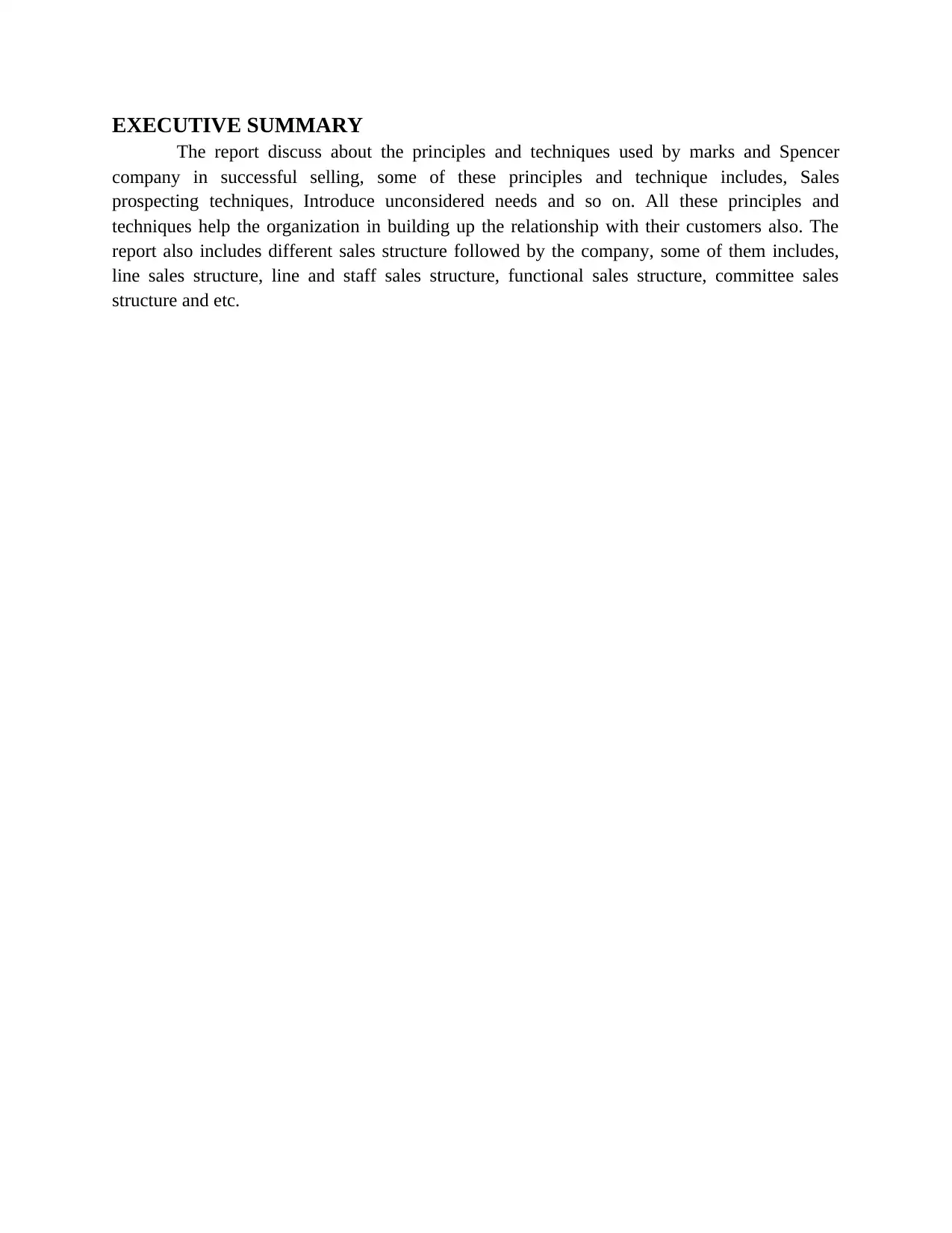
EXECUTIVE SUMMARY
The report discuss about the principles and techniques used by marks and Spencer
company in successful selling, some of these principles and technique includes, Sales
prospecting techniques, Introduce unconsidered needs and so on. All these principles and
techniques help the organization in building up the relationship with their customers also. The
report also includes different sales structure followed by the company, some of them includes,
line sales structure, line and staff sales structure, functional sales structure, committee sales
structure and etc.
The report discuss about the principles and techniques used by marks and Spencer
company in successful selling, some of these principles and technique includes, Sales
prospecting techniques, Introduce unconsidered needs and so on. All these principles and
techniques help the organization in building up the relationship with their customers also. The
report also includes different sales structure followed by the company, some of them includes,
line sales structure, line and staff sales structure, functional sales structure, committee sales
structure and etc.

Contents
EXECUTIVE SUMMARY.............................................................................................................2
INTRODUCTION...........................................................................................................................4
PRINCIPLES AND TECHNIQUES...............................................................................................4
SELLING THROUGH OTHERS....................................................................................................6
SALES STRUCTURE.....................................................................................................................6
CONCLUSION................................................................................................................................8
REFERNCES...................................................................................................................................9
EXECUTIVE SUMMARY.............................................................................................................2
INTRODUCTION...........................................................................................................................4
PRINCIPLES AND TECHNIQUES...............................................................................................4
SELLING THROUGH OTHERS....................................................................................................6
SALES STRUCTURE.....................................................................................................................6
CONCLUSION................................................................................................................................8
REFERNCES...................................................................................................................................9
⊘ This is a preview!⊘
Do you want full access?
Subscribe today to unlock all pages.

Trusted by 1+ million students worldwide
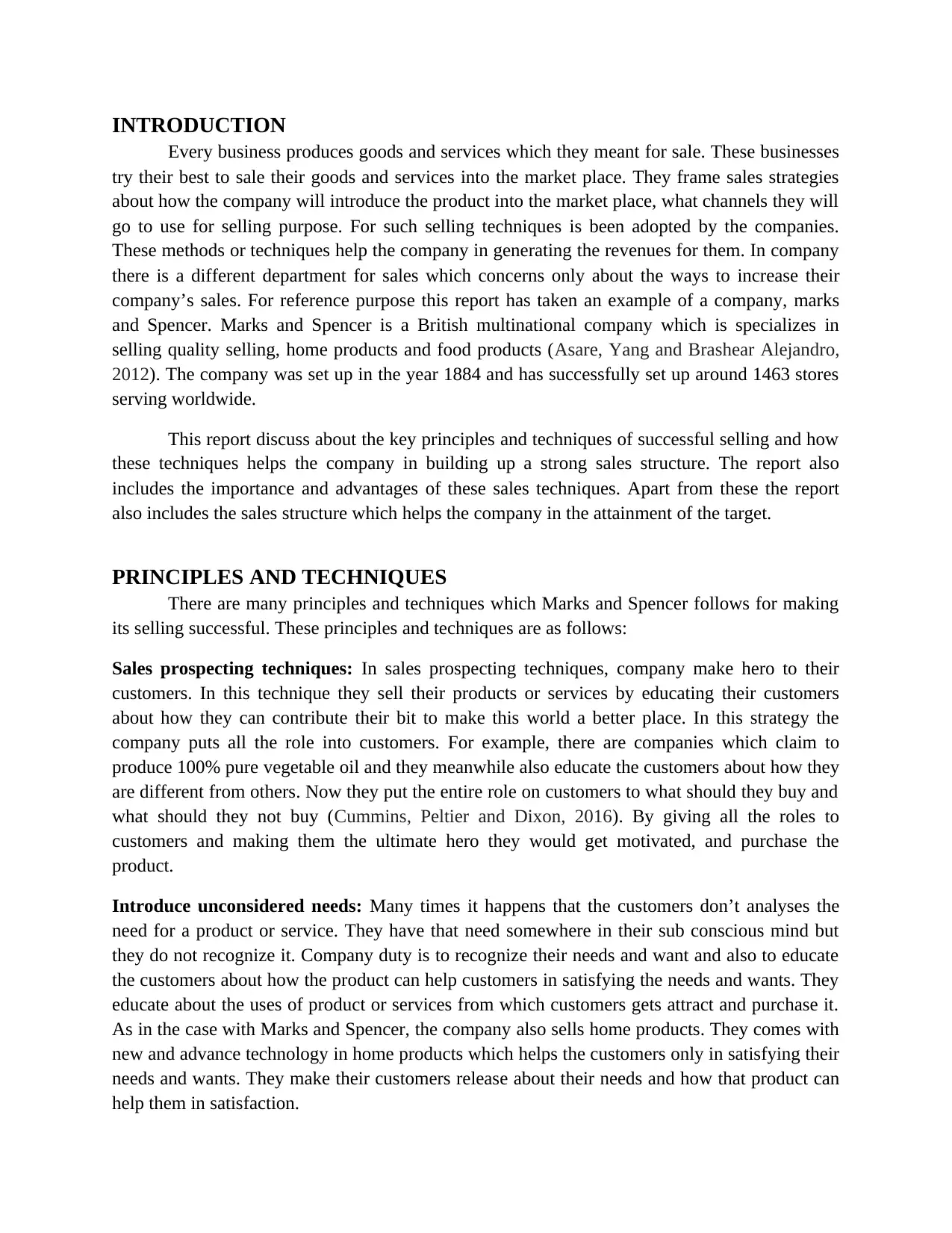
INTRODUCTION
Every business produces goods and services which they meant for sale. These businesses
try their best to sale their goods and services into the market place. They frame sales strategies
about how the company will introduce the product into the market place, what channels they will
go to use for selling purpose. For such selling techniques is been adopted by the companies.
These methods or techniques help the company in generating the revenues for them. In company
there is a different department for sales which concerns only about the ways to increase their
company’s sales. For reference purpose this report has taken an example of a company, marks
and Spencer. Marks and Spencer is a British multinational company which is specializes in
selling quality selling, home products and food products (Asare, Yang and Brashear Alejandro,
2012). The company was set up in the year 1884 and has successfully set up around 1463 stores
serving worldwide.
This report discuss about the key principles and techniques of successful selling and how
these techniques helps the company in building up a strong sales structure. The report also
includes the importance and advantages of these sales techniques. Apart from these the report
also includes the sales structure which helps the company in the attainment of the target.
PRINCIPLES AND TECHNIQUES
There are many principles and techniques which Marks and Spencer follows for making
its selling successful. These principles and techniques are as follows:
Sales prospecting techniques: In sales prospecting techniques, company make hero to their
customers. In this technique they sell their products or services by educating their customers
about how they can contribute their bit to make this world a better place. In this strategy the
company puts all the role into customers. For example, there are companies which claim to
produce 100% pure vegetable oil and they meanwhile also educate the customers about how they
are different from others. Now they put the entire role on customers to what should they buy and
what should they not buy (Cummins, Peltier and Dixon, 2016). By giving all the roles to
customers and making them the ultimate hero they would get motivated, and purchase the
product.
Introduce unconsidered needs: Many times it happens that the customers don’t analyses the
need for a product or service. They have that need somewhere in their sub conscious mind but
they do not recognize it. Company duty is to recognize their needs and want and also to educate
the customers about how the product can help customers in satisfying the needs and wants. They
educate about the uses of product or services from which customers gets attract and purchase it.
As in the case with Marks and Spencer, the company also sells home products. They comes with
new and advance technology in home products which helps the customers only in satisfying their
needs and wants. They make their customers release about their needs and how that product can
help them in satisfaction.
Every business produces goods and services which they meant for sale. These businesses
try their best to sale their goods and services into the market place. They frame sales strategies
about how the company will introduce the product into the market place, what channels they will
go to use for selling purpose. For such selling techniques is been adopted by the companies.
These methods or techniques help the company in generating the revenues for them. In company
there is a different department for sales which concerns only about the ways to increase their
company’s sales. For reference purpose this report has taken an example of a company, marks
and Spencer. Marks and Spencer is a British multinational company which is specializes in
selling quality selling, home products and food products (Asare, Yang and Brashear Alejandro,
2012). The company was set up in the year 1884 and has successfully set up around 1463 stores
serving worldwide.
This report discuss about the key principles and techniques of successful selling and how
these techniques helps the company in building up a strong sales structure. The report also
includes the importance and advantages of these sales techniques. Apart from these the report
also includes the sales structure which helps the company in the attainment of the target.
PRINCIPLES AND TECHNIQUES
There are many principles and techniques which Marks and Spencer follows for making
its selling successful. These principles and techniques are as follows:
Sales prospecting techniques: In sales prospecting techniques, company make hero to their
customers. In this technique they sell their products or services by educating their customers
about how they can contribute their bit to make this world a better place. In this strategy the
company puts all the role into customers. For example, there are companies which claim to
produce 100% pure vegetable oil and they meanwhile also educate the customers about how they
are different from others. Now they put the entire role on customers to what should they buy and
what should they not buy (Cummins, Peltier and Dixon, 2016). By giving all the roles to
customers and making them the ultimate hero they would get motivated, and purchase the
product.
Introduce unconsidered needs: Many times it happens that the customers don’t analyses the
need for a product or service. They have that need somewhere in their sub conscious mind but
they do not recognize it. Company duty is to recognize their needs and want and also to educate
the customers about how the product can help customers in satisfying the needs and wants. They
educate about the uses of product or services from which customers gets attract and purchase it.
As in the case with Marks and Spencer, the company also sells home products. They comes with
new and advance technology in home products which helps the customers only in satisfying their
needs and wants. They make their customers release about their needs and how that product can
help them in satisfaction.
Paraphrase This Document
Need a fresh take? Get an instant paraphrase of this document with our AI Paraphraser
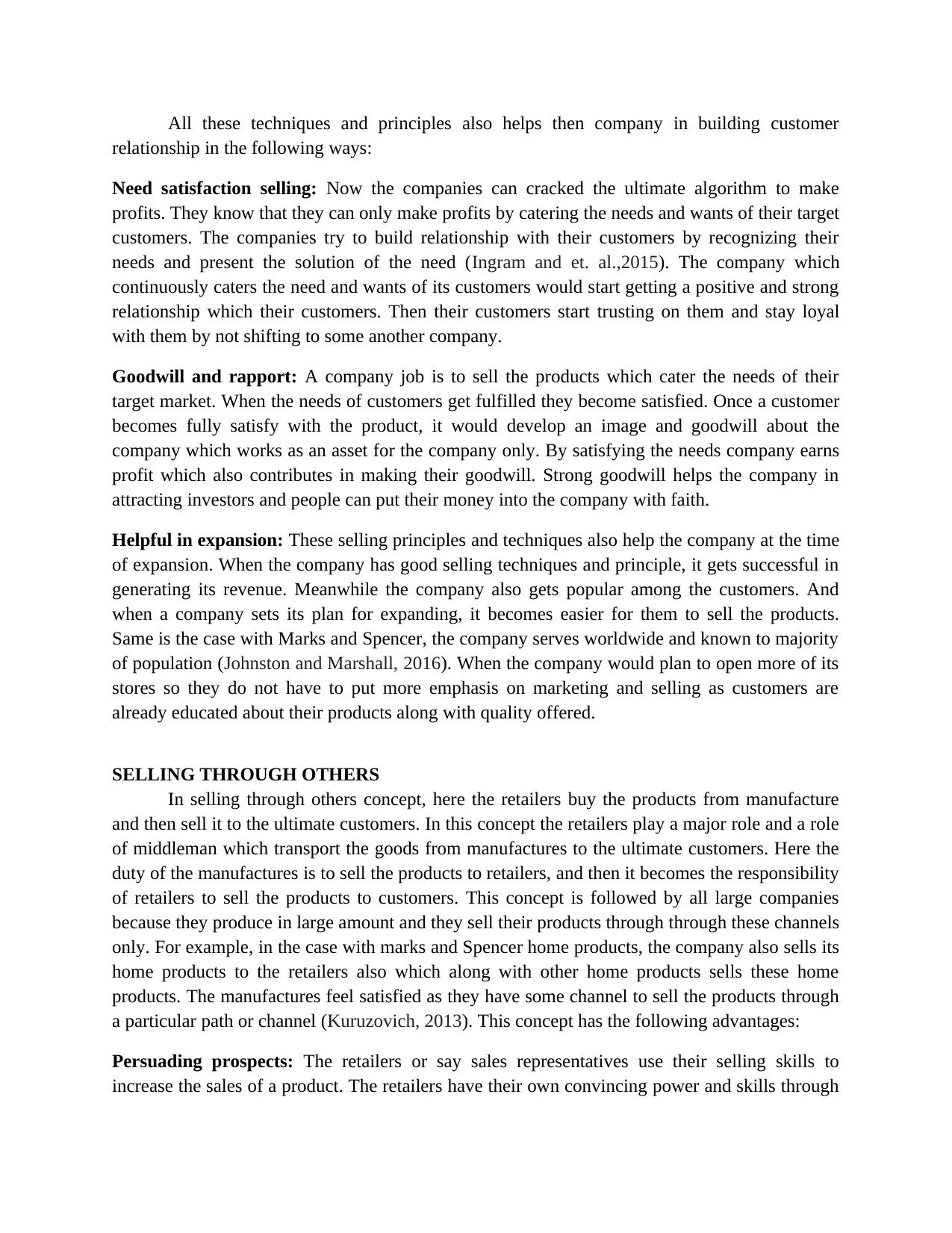
All these techniques and principles also helps then company in building customer
relationship in the following ways:
Need satisfaction selling: Now the companies can cracked the ultimate algorithm to make
profits. They know that they can only make profits by catering the needs and wants of their target
customers. The companies try to build relationship with their customers by recognizing their
needs and present the solution of the need (Ingram and et. al.,2015). The company which
continuously caters the need and wants of its customers would start getting a positive and strong
relationship which their customers. Then their customers start trusting on them and stay loyal
with them by not shifting to some another company.
Goodwill and rapport: A company job is to sell the products which cater the needs of their
target market. When the needs of customers get fulfilled they become satisfied. Once a customer
becomes fully satisfy with the product, it would develop an image and goodwill about the
company which works as an asset for the company only. By satisfying the needs company earns
profit which also contributes in making their goodwill. Strong goodwill helps the company in
attracting investors and people can put their money into the company with faith.
Helpful in expansion: These selling principles and techniques also help the company at the time
of expansion. When the company has good selling techniques and principle, it gets successful in
generating its revenue. Meanwhile the company also gets popular among the customers. And
when a company sets its plan for expanding, it becomes easier for them to sell the products.
Same is the case with Marks and Spencer, the company serves worldwide and known to majority
of population (Johnston and Marshall, 2016). When the company would plan to open more of its
stores so they do not have to put more emphasis on marketing and selling as customers are
already educated about their products along with quality offered.
SELLING THROUGH OTHERS
In selling through others concept, here the retailers buy the products from manufacture
and then sell it to the ultimate customers. In this concept the retailers play a major role and a role
of middleman which transport the goods from manufactures to the ultimate customers. Here the
duty of the manufactures is to sell the products to retailers, and then it becomes the responsibility
of retailers to sell the products to customers. This concept is followed by all large companies
because they produce in large amount and they sell their products through through these channels
only. For example, in the case with marks and Spencer home products, the company also sells its
home products to the retailers also which along with other home products sells these home
products. The manufactures feel satisfied as they have some channel to sell the products through
a particular path or channel (Kuruzovich, 2013). This concept has the following advantages:
Persuading prospects: The retailers or say sales representatives use their selling skills to
increase the sales of a product. The retailers have their own convincing power and skills through
relationship in the following ways:
Need satisfaction selling: Now the companies can cracked the ultimate algorithm to make
profits. They know that they can only make profits by catering the needs and wants of their target
customers. The companies try to build relationship with their customers by recognizing their
needs and present the solution of the need (Ingram and et. al.,2015). The company which
continuously caters the need and wants of its customers would start getting a positive and strong
relationship which their customers. Then their customers start trusting on them and stay loyal
with them by not shifting to some another company.
Goodwill and rapport: A company job is to sell the products which cater the needs of their
target market. When the needs of customers get fulfilled they become satisfied. Once a customer
becomes fully satisfy with the product, it would develop an image and goodwill about the
company which works as an asset for the company only. By satisfying the needs company earns
profit which also contributes in making their goodwill. Strong goodwill helps the company in
attracting investors and people can put their money into the company with faith.
Helpful in expansion: These selling principles and techniques also help the company at the time
of expansion. When the company has good selling techniques and principle, it gets successful in
generating its revenue. Meanwhile the company also gets popular among the customers. And
when a company sets its plan for expanding, it becomes easier for them to sell the products.
Same is the case with Marks and Spencer, the company serves worldwide and known to majority
of population (Johnston and Marshall, 2016). When the company would plan to open more of its
stores so they do not have to put more emphasis on marketing and selling as customers are
already educated about their products along with quality offered.
SELLING THROUGH OTHERS
In selling through others concept, here the retailers buy the products from manufacture
and then sell it to the ultimate customers. In this concept the retailers play a major role and a role
of middleman which transport the goods from manufactures to the ultimate customers. Here the
duty of the manufactures is to sell the products to retailers, and then it becomes the responsibility
of retailers to sell the products to customers. This concept is followed by all large companies
because they produce in large amount and they sell their products through through these channels
only. For example, in the case with marks and Spencer home products, the company also sells its
home products to the retailers also which along with other home products sells these home
products. The manufactures feel satisfied as they have some channel to sell the products through
a particular path or channel (Kuruzovich, 2013). This concept has the following advantages:
Persuading prospects: The retailers or say sales representatives use their selling skills to
increase the sales of a product. The retailers have their own convincing power and skills through

which they can convince or influence their customers to make them a purchase of the product.
This helps the company in increasing their revenue and also when the customer purchase their
products they would get to know about how this product is different from the other products.
through this they can differentiate the product with other products.
Selling complex products: The company which sells the products which are complex in nature
can easily demonstrate the products with its features about how the product is useful in a
person’s life. By this it is get easy for the customers to understand the usefulness of the product
and also it becomes easy for the company to sell it.
SALES STRUCTURE
Different company has different sales structure which they follow. Sales structure refers
to the formation of sales team. Businesses form different sales team accordingly to their product
and strategies.
Sales structure of Marks and Spencer
The company sales structure is very much simple. The company has its own
manufacturing units in which they produce the products. Then after the production of products,
the company through many supply channels transports their product to their showrooms or
stores. As in the case with their clothing line, the company manufactures the product after it gets
its design approval from designers. After the production the products gets transported to their
different stores (Lu, 2014). The company distributes the products according to the level of sales
also. For example if one store in London has large number of customer compared to the
customers in another stores then the company supply more variety to the store where there is
huge rush of customers. There are also many stores which does not have the latest collection by
the company. The company does that because may be that store doesn’t attract much customers
in them and the company just has opened it for the sake of expansion or for market share and
growth.
The sale structure of Marks and Spencer does not involve any complexity. The stores are
allotted which a particular ratio of stocks and inventory which they place to the manufacturing
unit. Company in advance plans about the total units of production that need to be taken for and
get it distributed in the required stores.
Implementation of different sales structure
There are different types of sales structure, some of them may include:
Line sales: It is the oldest form of sale structure which is generally followed by small scale
industries. In this the company or the firm caters the particular region of market which is
generally very small. Initial time, when Marks and Spencer introduce itself into the market place
This helps the company in increasing their revenue and also when the customer purchase their
products they would get to know about how this product is different from the other products.
through this they can differentiate the product with other products.
Selling complex products: The company which sells the products which are complex in nature
can easily demonstrate the products with its features about how the product is useful in a
person’s life. By this it is get easy for the customers to understand the usefulness of the product
and also it becomes easy for the company to sell it.
SALES STRUCTURE
Different company has different sales structure which they follow. Sales structure refers
to the formation of sales team. Businesses form different sales team accordingly to their product
and strategies.
Sales structure of Marks and Spencer
The company sales structure is very much simple. The company has its own
manufacturing units in which they produce the products. Then after the production of products,
the company through many supply channels transports their product to their showrooms or
stores. As in the case with their clothing line, the company manufactures the product after it gets
its design approval from designers. After the production the products gets transported to their
different stores (Lu, 2014). The company distributes the products according to the level of sales
also. For example if one store in London has large number of customer compared to the
customers in another stores then the company supply more variety to the store where there is
huge rush of customers. There are also many stores which does not have the latest collection by
the company. The company does that because may be that store doesn’t attract much customers
in them and the company just has opened it for the sake of expansion or for market share and
growth.
The sale structure of Marks and Spencer does not involve any complexity. The stores are
allotted which a particular ratio of stocks and inventory which they place to the manufacturing
unit. Company in advance plans about the total units of production that need to be taken for and
get it distributed in the required stores.
Implementation of different sales structure
There are different types of sales structure, some of them may include:
Line sales: It is the oldest form of sale structure which is generally followed by small scale
industries. In this the company or the firm caters the particular region of market which is
generally very small. Initial time, when Marks and Spencer introduce itself into the market place
⊘ This is a preview!⊘
Do you want full access?
Subscribe today to unlock all pages.

Trusted by 1+ million students worldwide

then at that time they opened up a small stall in some Bazaar in London (Powers, Jennings and
DeCarlo, 2014). Here they have target a particular region i.e. London which is comparatively
smaller then what it is targeting today.
The line and staff sales: This concept is followed by medium and large scale companies. In this
the company is dealing with diverse products in a wide geographical area. When marks and
Spencer, expands its stores at other parts of the city or to the other cities, then it adopt this
concept. In this the company with top sales executives forms group of specialists, expert dealers
and distribution channels to increase their sales for revenues purpose. These sales executives,
group specialist , expert dealers and etc help the company in selling of their products.
Functional sales: In this concept each employee or executive has a distinct duties. For example
the sales person receives orders or command from different sales executives but of different
work and duties. This structure is not flexible for small scale companies.
Committee sales: This is the structure which is at present followed by marks and Spencer. In
this the company’s executive group forms the plans and policy and implementation of such plans
and policies is done by individual executives (Rodriguez, Peterson and Krishnan, 2012). They
also train their sales committee.
Forming the sales strategies is very much necessary for a business. By forming the sales
strategy the company can assume the total number of sales it can have in a particular time period.
Making sales strategies in a defined sales structure helps the company in:
Anticipating the sales: The formation of sales strategy in a defined sale structure helps the
company in predicting the volume for sales which they can have in a particular time period. By
anticipating such, company allocate the resources accordingly which also helps the company in
proper allocation of required resources.
Creating Demand: Sales strategies also responsible for creating the demand for the product.
According to the predicted sales and to achieve that target, the company has to do its marketing
and promotional activities accordingly.
Execution of orders: sales structure helps the company in executing the orders without delay.
When the company forms a proper sales strategies, it also becomes very much necessary for
them to execute it. Otherwise it can create problems in decided plans and strategies.
If the company would adopt an efficient sales structure it helps the company in building a
strong financial viably by the following ways:
Increase in revenue: If the sales of a company increase, its revenue also gets increases with
that. The basic purpose of business to make profits and it can gain profits only if it would be able
to sell its product into market. Efficient sales planning help the organization in making revenue
for the company.
DeCarlo, 2014). Here they have target a particular region i.e. London which is comparatively
smaller then what it is targeting today.
The line and staff sales: This concept is followed by medium and large scale companies. In this
the company is dealing with diverse products in a wide geographical area. When marks and
Spencer, expands its stores at other parts of the city or to the other cities, then it adopt this
concept. In this the company with top sales executives forms group of specialists, expert dealers
and distribution channels to increase their sales for revenues purpose. These sales executives,
group specialist , expert dealers and etc help the company in selling of their products.
Functional sales: In this concept each employee or executive has a distinct duties. For example
the sales person receives orders or command from different sales executives but of different
work and duties. This structure is not flexible for small scale companies.
Committee sales: This is the structure which is at present followed by marks and Spencer. In
this the company’s executive group forms the plans and policy and implementation of such plans
and policies is done by individual executives (Rodriguez, Peterson and Krishnan, 2012). They
also train their sales committee.
Forming the sales strategies is very much necessary for a business. By forming the sales
strategy the company can assume the total number of sales it can have in a particular time period.
Making sales strategies in a defined sales structure helps the company in:
Anticipating the sales: The formation of sales strategy in a defined sale structure helps the
company in predicting the volume for sales which they can have in a particular time period. By
anticipating such, company allocate the resources accordingly which also helps the company in
proper allocation of required resources.
Creating Demand: Sales strategies also responsible for creating the demand for the product.
According to the predicted sales and to achieve that target, the company has to do its marketing
and promotional activities accordingly.
Execution of orders: sales structure helps the company in executing the orders without delay.
When the company forms a proper sales strategies, it also becomes very much necessary for
them to execute it. Otherwise it can create problems in decided plans and strategies.
If the company would adopt an efficient sales structure it helps the company in building a
strong financial viably by the following ways:
Increase in revenue: If the sales of a company increase, its revenue also gets increases with
that. The basic purpose of business to make profits and it can gain profits only if it would be able
to sell its product into market. Efficient sales planning help the organization in making revenue
for the company.
Paraphrase This Document
Need a fresh take? Get an instant paraphrase of this document with our AI Paraphraser
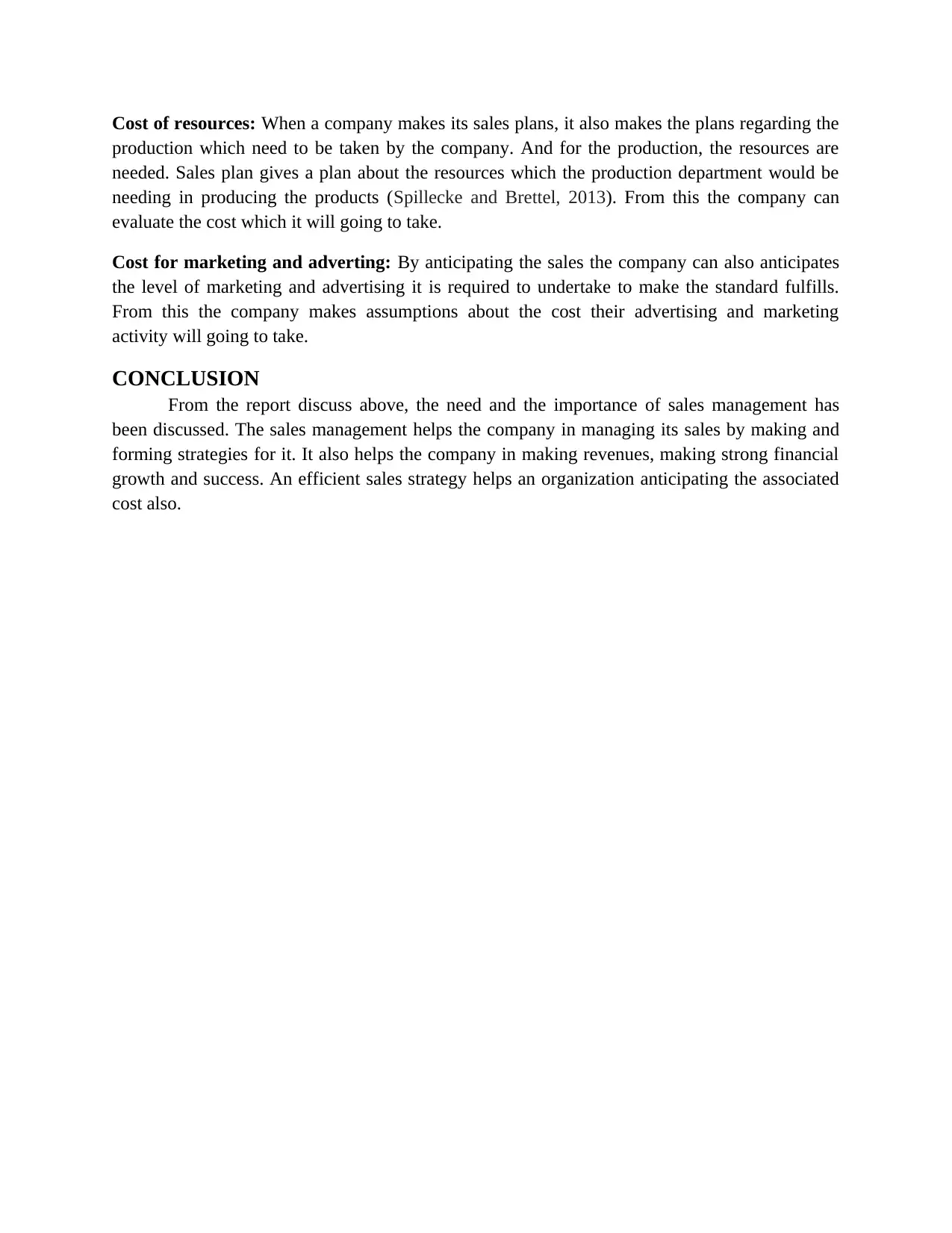
Cost of resources: When a company makes its sales plans, it also makes the plans regarding the
production which need to be taken by the company. And for the production, the resources are
needed. Sales plan gives a plan about the resources which the production department would be
needing in producing the products (Spillecke and Brettel, 2013). From this the company can
evaluate the cost which it will going to take.
Cost for marketing and adverting: By anticipating the sales the company can also anticipates
the level of marketing and advertising it is required to undertake to make the standard fulfills.
From this the company makes assumptions about the cost their advertising and marketing
activity will going to take.
CONCLUSION
From the report discuss above, the need and the importance of sales management has
been discussed. The sales management helps the company in managing its sales by making and
forming strategies for it. It also helps the company in making revenues, making strong financial
growth and success. An efficient sales strategy helps an organization anticipating the associated
cost also.
production which need to be taken by the company. And for the production, the resources are
needed. Sales plan gives a plan about the resources which the production department would be
needing in producing the products (Spillecke and Brettel, 2013). From this the company can
evaluate the cost which it will going to take.
Cost for marketing and adverting: By anticipating the sales the company can also anticipates
the level of marketing and advertising it is required to undertake to make the standard fulfills.
From this the company makes assumptions about the cost their advertising and marketing
activity will going to take.
CONCLUSION
From the report discuss above, the need and the importance of sales management has
been discussed. The sales management helps the company in managing its sales by making and
forming strategies for it. It also helps the company in making revenues, making strong financial
growth and success. An efficient sales strategy helps an organization anticipating the associated
cost also.
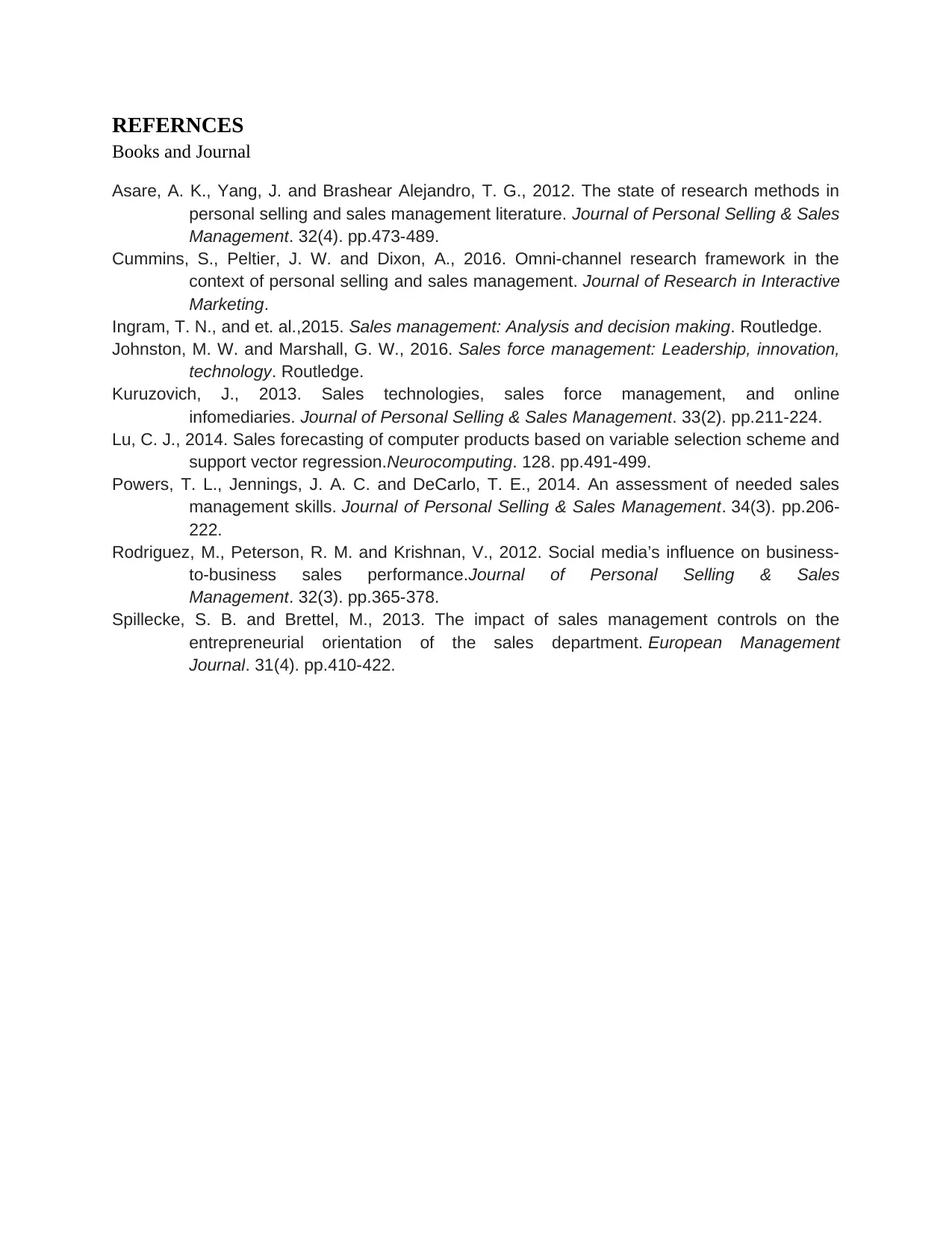
REFERNCES
Books and Journal
Asare, A. K., Yang, J. and Brashear Alejandro, T. G., 2012. The state of research methods in
personal selling and sales management literature. Journal of Personal Selling & Sales
Management. 32(4). pp.473-489.
Cummins, S., Peltier, J. W. and Dixon, A., 2016. Omni-channel research framework in the
context of personal selling and sales management. Journal of Research in Interactive
Marketing.
Ingram, T. N., and et. al.,2015. Sales management: Analysis and decision making. Routledge.
Johnston, M. W. and Marshall, G. W., 2016. Sales force management: Leadership, innovation,
technology. Routledge.
Kuruzovich, J., 2013. Sales technologies, sales force management, and online
infomediaries. Journal of Personal Selling & Sales Management. 33(2). pp.211-224.
Lu, C. J., 2014. Sales forecasting of computer products based on variable selection scheme and
support vector regression.Neurocomputing. 128. pp.491-499.
Powers, T. L., Jennings, J. A. C. and DeCarlo, T. E., 2014. An assessment of needed sales
management skills. Journal of Personal Selling & Sales Management. 34(3). pp.206-
222.
Rodriguez, M., Peterson, R. M. and Krishnan, V., 2012. Social media’s influence on business-
to-business sales performance.Journal of Personal Selling & Sales
Management. 32(3). pp.365-378.
Spillecke, S. B. and Brettel, M., 2013. The impact of sales management controls on the
entrepreneurial orientation of the sales department. European Management
Journal. 31(4). pp.410-422.
Books and Journal
Asare, A. K., Yang, J. and Brashear Alejandro, T. G., 2012. The state of research methods in
personal selling and sales management literature. Journal of Personal Selling & Sales
Management. 32(4). pp.473-489.
Cummins, S., Peltier, J. W. and Dixon, A., 2016. Omni-channel research framework in the
context of personal selling and sales management. Journal of Research in Interactive
Marketing.
Ingram, T. N., and et. al.,2015. Sales management: Analysis and decision making. Routledge.
Johnston, M. W. and Marshall, G. W., 2016. Sales force management: Leadership, innovation,
technology. Routledge.
Kuruzovich, J., 2013. Sales technologies, sales force management, and online
infomediaries. Journal of Personal Selling & Sales Management. 33(2). pp.211-224.
Lu, C. J., 2014. Sales forecasting of computer products based on variable selection scheme and
support vector regression.Neurocomputing. 128. pp.491-499.
Powers, T. L., Jennings, J. A. C. and DeCarlo, T. E., 2014. An assessment of needed sales
management skills. Journal of Personal Selling & Sales Management. 34(3). pp.206-
222.
Rodriguez, M., Peterson, R. M. and Krishnan, V., 2012. Social media’s influence on business-
to-business sales performance.Journal of Personal Selling & Sales
Management. 32(3). pp.365-378.
Spillecke, S. B. and Brettel, M., 2013. The impact of sales management controls on the
entrepreneurial orientation of the sales department. European Management
Journal. 31(4). pp.410-422.
⊘ This is a preview!⊘
Do you want full access?
Subscribe today to unlock all pages.

Trusted by 1+ million students worldwide
1 out of 9
Related Documents
Your All-in-One AI-Powered Toolkit for Academic Success.
+13062052269
info@desklib.com
Available 24*7 on WhatsApp / Email
![[object Object]](/_next/static/media/star-bottom.7253800d.svg)
Unlock your academic potential
Copyright © 2020–2025 A2Z Services. All Rights Reserved. Developed and managed by ZUCOL.





